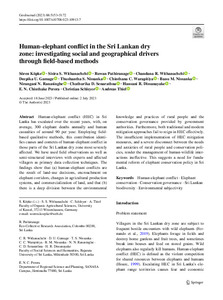| dc.date.accessioned | 2023-10-18T15:38:48Z | |
| dc.date.available | 2023-10-18T15:38:48Z | |
| dc.date.issued | 2023-07-02 | |
| dc.identifier | doi:10.17170/kobra-202310188876 | |
| dc.identifier.uri | http://hdl.handle.net/123456789/15116 | |
| dc.description.sponsorship | Gefördert im Rahmen des Projekts DEAL | ger |
| dc.language.iso | eng | |
| dc.rights | Namensnennung 4.0 International | * |
| dc.rights.uri | http://creativecommons.org/licenses/by/4.0/ | * |
| dc.subject | Human-elephant conflict | eng |
| dc.subject | Elephant conservation | eng |
| dc.subject | Conservation governance | eng |
| dc.subject | Sri Lankan biodiversity | eng |
| dc.subject | Environmental subjectivity | eng |
| dc.subject.ddc | 550 | |
| dc.subject.ddc | 570 | |
| dc.subject.ddc | 590 | |
| dc.title | Human‑elephant conflict in the Sri Lankan dry zone: investigating social and geographical drivers through field‑based methods | eng |
| dc.type | Aufsatz | |
| dcterms.abstract | Human-elephant conflict (HEC) in Sri Lanka has escalated over the recent years, with, on average, 300 elephant deaths annually and human casualties of around 90 per year. Employing field-based qualitative methods, this contribution identifies causes and contexts of human-elephant conflict in those parts of the Sri Lankan dry zone most severely affected. We have used field observations as well as semi-structured interviews with experts and affected villagers as primary data collection techniques. The findings show that (a) human-elephant conflicts are the result of land-use decisions, encroachment on elephant corridors, changes in agricultural production systems, and commercialization of land, and that (b) there is a deep division between the environmental knowledge and practices of rural people and the conservation governance provided by government authorities. Furthermore, both traditional and modern mitigation approaches fail to reign in HEC effectively. The insufficient implementation of HEC mitigation measures, and a severe disconnect between the needs and anxieties of rural people and conservation policies, render the management of human-wildlife interactions ineffective. This suggests a need for fundamental reform of elephant conservation policy in Sri Lanka. | eng |
| dcterms.accessRights | open access | |
| dcterms.creator | Köpke, Sören | |
| dcterms.creator | Withanachchi, Sisira Saddhamangala | |
| dcterms.creator | Pathiranage, Ruwan | |
| dcterms.creator | Withanachchi, Chandana Rohana | |
| dcterms.creator | Gamage Name, Deepika Udayakanthi | |
| dcterms.creator | Nissanka, Thushantha S. | |
| dcterms.creator | Warapitiya, Chinthana Chathuranga | |
| dcterms.creator | Nissanka, Banu Madhuratha | |
| dcterms.creator | Chinthake Perera, E. N. | |
| dcterms.creator | Schleyer, Christian | |
| dcterms.creator | Thiel, Andreas | |
| dcterms.extent | 20 Seiten | |
| dc.relation.doi | doi:10.1007/s10708-023-10913-7 | |
| dc.subject.swd | Sri Lanka | ger |
| dc.subject.swd | Elefanten | ger |
| dc.subject.swd | Tierschutz | ger |
| dc.subject.swd | Naturschutzverwaltung | ger |
| dc.subject.swd | Konflikt | ger |
| dc.type.version | publishedVersion | |
| dcterms.source.identifier | eissn:1572-9893 | |
| dcterms.source.issue | issue 5 | |
| dcterms.source.journal | GeoJournal | eng |
| dcterms.source.volume | Volume 88 | |
| kup.iskup | false | |


